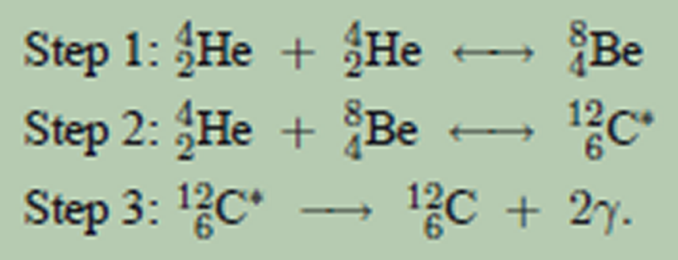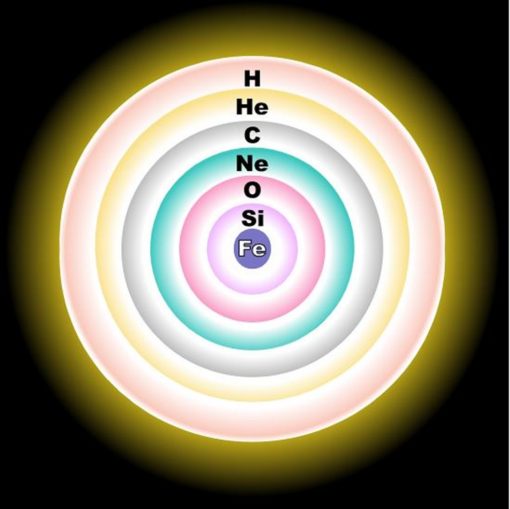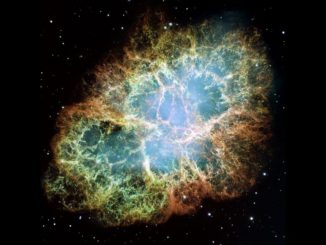Previously, we looked at our Sun and how it works however only a small part was covered. We saw that quantum tunneling allowed protons to fuse in conditions that classical physics – that relying only on kinetic energy being enough to overcome the electrostatic coulomb barrier – would allow. This article will cover the main parts of the rest of the process going on in the Sun as well as larger stars.
Larger, heavier elements
So far, we have fused 2 protons together however a process called β+ decay converts one of the protons in to a neutron to make the nucleus stable – consider that both protons are positive in charge so they will want to repel. The thing we have now is a deuteron with 1 proton and 1 neutron which is written as 21H. It has 2 ‘things’ in the nucleus and 1 of them is a proton with the H denoting it as hydrogen; it is a hydrogen isotope meaning that it is like hydrogen but slightly different. At this stage, it is likely that a stray passing proton (remember this is a hydrogen nucleus and hydrogen is plentiful in our Sun) will fuse with this creating 32He which is a helium isotope with 3 nucleons, 2 of which are protons and the other is a neutron. More often than not in our Sun, this will react with another 32He created similarly and form a true helium nucleus 42He and 2 separate protons. Congratulations, you have now navigated what is known as PPI which is the most common branch of our star’s proton-proton fusion chain!
To summarise, stars use hydrogen ions which are simply protons and jamb them together in a process called fusion. Along the way, β+ decay which converts protons in to neutrons and β- decay which converts neutrons in to protons ensure that the particle remains stable. At each instance, other particles such as electrons, neutrinos as well as their anti counterparts are created and emitted which contributes to the star’s energy output but the important thing to note is that simply from hydrogen, the most basic matter known, heavier and larger matter is created.
Remembering that stars have mass and therefore gravity, this gravity constantly tries to collapse the star however the fusing or burning going on in the star’s core keeps gravity at bay thereby creating equilibrium. Once they hydrogen levels become depleted, this radiation pressure reduces and the star begins to be compressed by gravity. If you compress a gas then the temperature increases and in this instance, there is now enough energy to fuse helium which is abundant. The 42He begins to be fuse with other 42He particles in what is known as the triple-alpha process – a helium nucleus is known as an alpha particle. Here, Carbon 12 which is stable is created as is Beryllium 8 but this isn’t stable so if it doesn’t fuse with another alpha particle quickly, it will reduce to multiple, smaller nuclei. The triple-alpha process is shown below – note the number of protons and neutrons (nucleons) at the top and the number of protons at the bottom prior to each chemical symbol and see how they are formed.

The asterisk against 126C means that it is in an excited state known as the Hoyle state.
We now have carbon being created through fusing helium that itself was created by fusing hydrogen. This triple-alpha-process will occur in our Sun once it begins to die and become a red giant.
Larger stars
This process is also part of the ageing process of larger stars. Here, the mass is so great that gravity will create ever higher temperatures. Once helium is consumed in to carbon then this too will fuse creating elements such as 2010Ne, 2311Na and 2312Mg with traces of helium as well as leftover protons and neutrons along the way. This process creates shells of material within the star. These shells will burn or fuse until there is insufficient energy caused by gravitational pressure for them to fuse further. This means the burning part of the star becomes smaller and the gravitational pressure increases. Below is an image of how this looks.

User:Rursus [CC BY-SA]
This image represents the shells of a star ≥ 11 times the mass of our Sun. As higher temperatures are required to burn these larger elements so stars have different colours. Smaller stars such as our Sun burn white whereas more massive stars like those in Orion’s Belt appear blue. Stars which are slowly dying (red giants) appear red, these can be seen with the naked eye or binoculars. Look up Betelgeuse, Aldebaran and Arcturus on a sky app on your phone.
The timescales for burning of each shell differs considerably. Helium will burn for around 106 years, carbon for around 500 years, neon for about a year, oxygen for 6 months and silicon for a day – when it stops, it stops quickly. This is how almost every element that we see, that we use, that we eat, of which we are made, is created.
What happens next creates even heavier elements, is quick and exciting.
© Rat Catcher 2017



